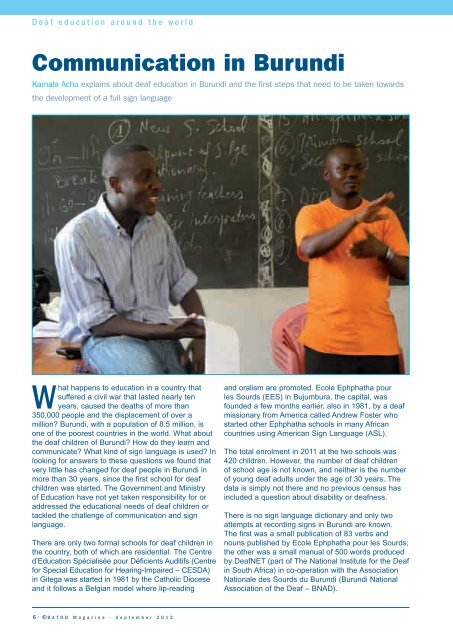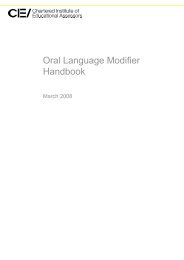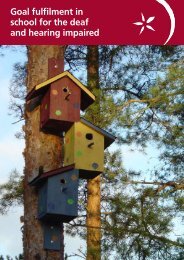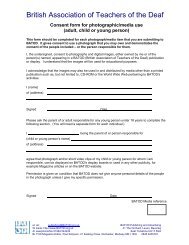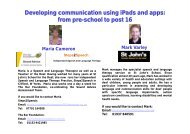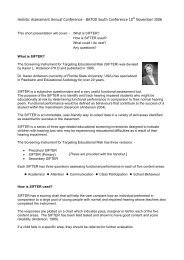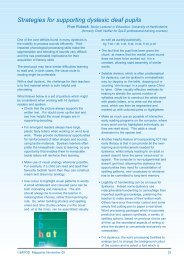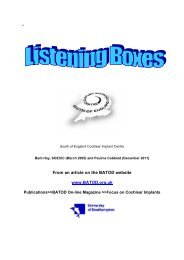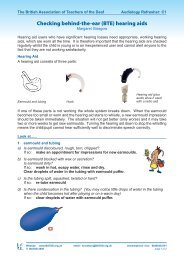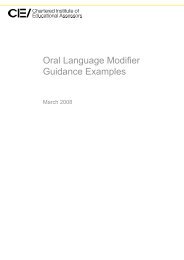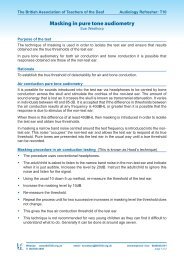Communication in Burundi - batod
Communication in Burundi - batod
Communication in Burundi - batod
You also want an ePaper? Increase the reach of your titles
YUMPU automatically turns print PDFs into web optimized ePapers that Google loves.
Deaf education around the world<br />
<strong>Communication</strong> <strong>in</strong> <strong>Burundi</strong><br />
Kamala Achu expla<strong>in</strong>s about deaf education <strong>in</strong> <strong>Burundi</strong> and the first steps that need to be taken towards<br />
the development of a full sign language<br />
What happens to education <strong>in</strong> a country that<br />
suffered a civil war that lasted nearly ten<br />
years, caused the deaths of more than<br />
350,000 people and the displacement of over a<br />
million <strong>Burundi</strong>, with a population of 8.5 million, is<br />
one of the poorest countries <strong>in</strong> the world. What about<br />
the deaf children of <strong>Burundi</strong> How do they learn and<br />
communicate What k<strong>in</strong>d of sign language is used In<br />
look<strong>in</strong>g for answers to these questions we found that<br />
very little has changed for deaf people <strong>in</strong> <strong>Burundi</strong> <strong>in</strong><br />
more than 30 years, s<strong>in</strong>ce the first school for deaf<br />
children was started. The Government and M<strong>in</strong>istry<br />
of Education have not yet taken responsibility for or<br />
addressed the educational needs of deaf children or<br />
tackled the challenge of communication and sign<br />
language.<br />
There are only two formal schools for deaf children <strong>in</strong><br />
the country, both of which are residential. The Centre<br />
d’Education Spécialisée pour Déficients Auditifs (Centre<br />
for Special Education for Hear<strong>in</strong>g-Impaired – CESDA)<br />
<strong>in</strong> Gitega was started <strong>in</strong> 1981 by the Catholic Diocese<br />
and it follows a Belgian model where lip-read<strong>in</strong>g<br />
and oralism are promoted. Ecole Ephphatha pour<br />
les Sourds (EES) <strong>in</strong> Bujumbura, the capital, was<br />
founded a few months earlier, also <strong>in</strong> 1981, by a deaf<br />
missionary from America called Andrew Foster who<br />
started other Ephphatha schools <strong>in</strong> many African<br />
countries us<strong>in</strong>g American Sign Language (ASL).<br />
The total enrolment <strong>in</strong> 2011 at the two schools was<br />
420 children. However, the number of deaf children<br />
of school age is not known, and neither is the number<br />
of young deaf adults under the age of 30 years. The<br />
data is simply not there and no previous census has<br />
<strong>in</strong>cluded a question about disability or deafness.<br />
There is no sign language dictionary and only two<br />
attempts at record<strong>in</strong>g signs <strong>in</strong> <strong>Burundi</strong> are known.<br />
The first was a small publication of 83 verbs and<br />
nouns published by Ecole Ephphatha pour les Sourds;<br />
the other was a small manual of 500 words produced<br />
by DeafNET (part of The National Institute for the Deaf<br />
<strong>in</strong> South Africa) <strong>in</strong> co-operation with the Association<br />
Nationale des Sourds du <strong>Burundi</strong> (<strong>Burundi</strong> National<br />
Association of the Deaf – BNAD).<br />
6 • © BATOD Magaz<strong>in</strong>e • September 2012
Deaf education around the world<br />
children to start develop<strong>in</strong>g their own ‘secret’ signs.<br />
Deaf people who have had a chance to travel to or<br />
to study <strong>in</strong> neighbour<strong>in</strong>g countries will be subject to<br />
those outside <strong>in</strong>fluences because they will have<br />
picked up local vocabulary.<br />
It is commonly accepted that ASL is the basis of the<br />
sign language used by those who sign <strong>in</strong> <strong>Burundi</strong>;<br />
however, the <strong>in</strong>fluences from neighbour<strong>in</strong>g countries<br />
such as Kenya, Uganda, Tanzania and Rwanda<br />
are keenly felt and commented on. The need for a<br />
<strong>Burundi</strong>an sign language emerged strongly at a recent<br />
meet<strong>in</strong>g to discuss priorities with several deaf and<br />
hear<strong>in</strong>g groups. There was no consensus about the<br />
existence of a <strong>Burundi</strong>an Sign Language. However,<br />
the majority felt that <strong>Burundi</strong>an culture and traditions<br />
and also regional differences with<strong>in</strong> the country have<br />
to be taken <strong>in</strong>to consideration, as well as all the<br />
nuances of the various languages spoken <strong>in</strong> <strong>Burundi</strong> –<br />
Kirundi, French, Swahili and English. Maurice Murishi,<br />
headmaster of EES, recounted how his teachers had<br />
got together to decide the sign for ‘Moses’ as they had<br />
found different and conflict<strong>in</strong>g signs for the name.<br />
In October 2011 DOOR International Afrique launched<br />
Connaitre Dieu comment (How to know God) a<br />
set of six CDs conta<strong>in</strong><strong>in</strong>g 32 Bible stories. The cover<br />
says it is <strong>in</strong> <strong>Burundi</strong>an Sign Language; however, at<br />
the recent meet<strong>in</strong>g mentioned above there was<br />
no recognition or acceptance that a <strong>Burundi</strong>an<br />
Sign Language had been developed. There is<br />
no comprehensive dictionary and no evidence of<br />
a process hav<strong>in</strong>g taken place to develop the sign<br />
language which would necessarily have <strong>in</strong>volved deaf<br />
people, parents of deaf children, the schools and the<br />
deaf association and others such as professors from<br />
the l<strong>in</strong>guistics department of the University of <strong>Burundi</strong>.<br />
Fabien Hamisi of the BNAD says that it is a question<br />
of build<strong>in</strong>g capacity, help<strong>in</strong>g to develop sign language<br />
from what exists and is be<strong>in</strong>g used now. The BNAD<br />
runs classes <strong>in</strong> <strong>in</strong>formal sett<strong>in</strong>gs <strong>in</strong> three rural areas<br />
where groups of deaf children and young adults are<br />
taught sign language and basic literacy and numeracy.<br />
Others, <strong>in</strong>clud<strong>in</strong>g the teachers from the two schools,<br />
the parents and <strong>in</strong>terpreters, propose systematic<br />
research first to ascerta<strong>in</strong> the level, quality and <strong>in</strong>country<br />
similarities and differences of sign language<br />
and then to identify clearly the <strong>in</strong>fluences from<br />
neighbour<strong>in</strong>g countries. Most of all they want a sign<br />
language that is rooted <strong>in</strong> and reflects <strong>Burundi</strong>’s rich<br />
cultural and l<strong>in</strong>guistic traditions. This will be a complex<br />
and challeng<strong>in</strong>g task and will necessarily <strong>in</strong>volve all<br />
the key players mentioned here as well as others who<br />
could provide more technical assistance.<br />
There is no doubt that the form of sign language used<br />
now <strong>in</strong> <strong>Burundi</strong> is a vibrant and expressive tool. After<br />
all, accord<strong>in</strong>g to the BNAD, nearly 1,000 deaf people<br />
use sign language as their ma<strong>in</strong> language and it<br />
should be the base from which a uniquely <strong>Burundi</strong>an<br />
national sign language is developed and ref<strong>in</strong>ed.<br />
Please email your comments to mail@ddpuk.org and<br />
visit our website at www.ddpuk.org/<br />
Kamala Achu works for Disability Development<br />
Partners, an organisation that has undertaken<br />
research <strong>in</strong>to the education and communication<br />
needs of deaf children and young people <strong>in</strong> <strong>Burundi</strong>.<br />
The groups mentioned above called for more research<br />
because there is a mixture of sign languages, and<br />
deaf people from one prov<strong>in</strong>ce will not understand<br />
those from another. Anyone who has attended an<br />
Ephphatha School will be us<strong>in</strong>g a sign language<br />
based on ASL. Pupils from CESDA will depend more<br />
on lip-read<strong>in</strong>g, although teachers there say that they<br />
now teach sign language and that it is not unusual for<br />
©BATOD Magaz<strong>in</strong>e • September 2012 • 7


